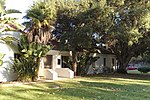Griffith Park
Griffith Park is a large municipal park at the eastern end of the Santa Monica Mountains, in the Los Feliz neighborhood of Los Angeles, California. The park covers 4,310 acres (1,740 ha) of land, making it one of the largest urban parks in North America. It is the second-largest city park in California, after Mission Trails Preserve in San Diego, and the 11th-largest municipally-owned park in the United States.The park features popular attractions such as the Los Angeles Zoo, the Autry Museum of the American West, the Griffith Observatory, and the Hollywood Sign. Due to its appearance in many films, the park is among the most famous municipal parks in North America.It has been compared to Central Park in New York City and Golden Gate Park in San Francisco, but it is much larger, more untamed, and rugged than either of those parks. The Los Angeles Recreation and Parks Commission adopted the characterization of the park as an "urban wilderness" on January 8, 2014.
Excerpt from the Wikipedia article Griffith Park (License: CC BY-SA 3.0, Authors).Griffith Park
West Alameda Avenue, Burbank
Geographical coordinates (GPS) Address Website External links Nearby Places Show on map
Geographical coordinates (GPS)
| Latitude | Longitude |
|---|---|
| N 34.133333333333 ° | E -118.3 ° |
Address
Griffith Park
West Alameda Avenue
91506 Burbank
California, United States
Open on Google Maps










